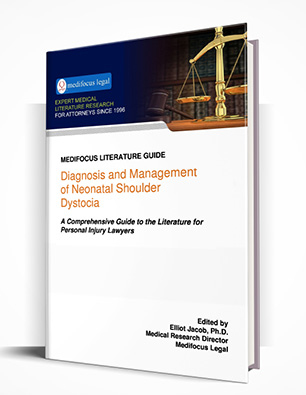Diagnosis and Management of Neonatal Shoulder DystociaA Comprehensive Guide to the Literature for Personal Injury Lawyers
Publisher: Medifocus Legal
Publication Date: March 28, 2017
Number of Pages: 140
A Comprehensive Guide to the Literature for Personal Injury Lawyers
Publisher: Medifocus LegalPublication Date: March 28, 2017
Number of Pages: 140
1. Despite the recognition of both specific maternal and fetal risk factors, shoulder dystocia remains a largely unpreventable and unpredictable obstetric emergency.
2. Shoulder dystocia is difficult to manage because currently there are no fool-proof and absolute algorithms for its management.
3. Shoulder dystocia carries a high risk of serious birth injuries and maternal complications.
4. Even if shoulder dystocia is managed appropriately, a bad outcome often prompts the filing of a medical negligence lawsuit against the attending obstetrician and/or members of the delivery team.
The overall incidence of shoulder dystocia appears to be related to fetal weight, occurring in up to 1.4% of all infants with a birth weight between 2,500 to 4,000 grams, but increases to up to 9% among fetuses weighing 4,000 to 4,500 grams born to mothers without diabetes. The risk of a birth complicated by shoulder dystocia is about 6 times higher in women with diabetes compared to the general population.
Shoulder dystocia has been linked to significant complications for both the mother and the fetus. The most frequent maternal complications of shoulder dystocia are postpartum hemorrhage and fourth-degree perineal tears. Brachial plexus injury, including Erb palsy and Klumpke palsy, is one of the most common fetal complications associated with shulder dystocia, occurring in 4 to 40% of cases. Although nearly all of these neonatal palsies resolve within 12-months, permanent nerve damage has been reported to persist in about 10% of cases.
The most devastating potential complication of a birth complicated by shoulder dystocia is fetal asphyxia. This occurs during a shoulder dystocia delivery when the baby's umbilical cord becomes tightly compressed between the fetal body and the mother's pelvis which significantly reduces the amount of blood flow to the infant.
Despite the lack of universally accepted management algorithms, there are several key factors that play an important role in the successful management of a vaginal delivery that is complicated by shoulder dystocia. These factors include constant preparedness and training, developing a formalized activation system, and good leadership and organization of team members when shoulder dystocia is recognized.
The MediFocus Literature Guide to the Diagnosis and Management of Neonatal Shoulder Dystocia is a comprehensive reference guide to the medical literature for personal injury lawyers involved in litigating cases of shoulder dystocia that is alleged to be the cause of a serious birth injury. This unique Guide consists of nearly 160 hand-selected journal article references with links to the article abstracts that focus on the diagnosis, management, complications and outcomes of neonatal shoulder dystocia as documented in the peer-reviewed medical literature during the past two decades.
 |
- A comprehensive bibliography of 157 journal article references indexed in MEDLINE published in well respected medical and scientific journals.
- Online access to the abstracts (summaries) of the articles.
- Online access to the free full-text version of 10 articles.
- Links to full-text sources of other articles that are available for purchase directly from individual journal publishers.
- A unique "Author Directory" consisting of the names and institutional affiliations of experts who have published and have specialized knowledge about Diagnosis and Management of Neonatal Shoulder Dystocia. The "Author Directory" is a valuable resource for quickly identifying and locating experts for case reviews, opinions, and testimony.
Select examples of topics that are covered by the articles referenced in this Guidebook include:
- Shoulder dystocia and associated maneuvers as risk factors for perineal trauma.
- The role of episiotomy in prevention and management of shoulder dystocia: a systematic review
- Neonatal morbidity associated with shoulder dystocia maneuvers.
- Shoulder dystocia in diabetic and non-diabetic pregnancies.
- Neonatal injury at cephalic vaginal delivery: a retrospective analysis of extent of association with shoulder dystocia.
- Risk factors for neonatal brachial plexus palsy.
- Shoulder dystocia: management and documentation.
- Shoulder dystocia: risk factors, predictability, and preventability.
- A multicenter assessment of 1,177 cases of shoulder dystocia: lessons learned.
- Fetal macrosomia and shoulder dystocia in women with gestational diabetes: risks amenable to treatment?
- A comparison of obstetric maneuvers for the acute management of shoulder dystocia.
- Reducing the risk of shoulder dystocia and associated brachial plexus injury.
- Comparison of perinatal outcomes of shoulder dystocia alleviated by different type and sequence of maneuvers: a retrospective review.
- Is it possible to reduce obstetrical brachial plexus palsy by optimal management of shoulder dystocia?
- Antenatal and intrapartum prediction of shoulder dystocia.
- Shoulder dystocia: comparison of the ACOG practice bulletin with another national guideline.
- Shoulder dystocia related fetal neurological injuries: the predisposing roles of forceps and ventouse extractions.
- The risk of shoulder dystocia related permanent fetal injury in relation to birth weight.
- Shoulder dystocia with and without brachial plexus injury: experience from three centers.
- Intrapartum interventions for preventing shoulder dystocia.
is available in two formats: | |
Order by Phone:To order by phone, please call: Order by Mail:To order by mail, please print and complete this Order Form | |

